







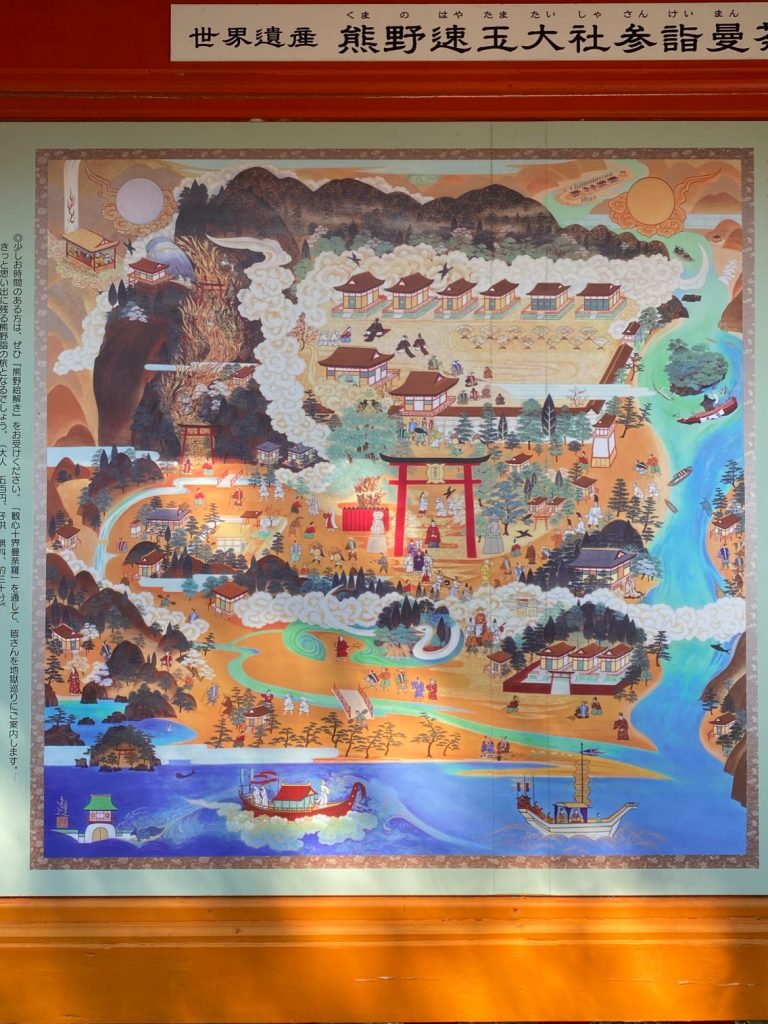
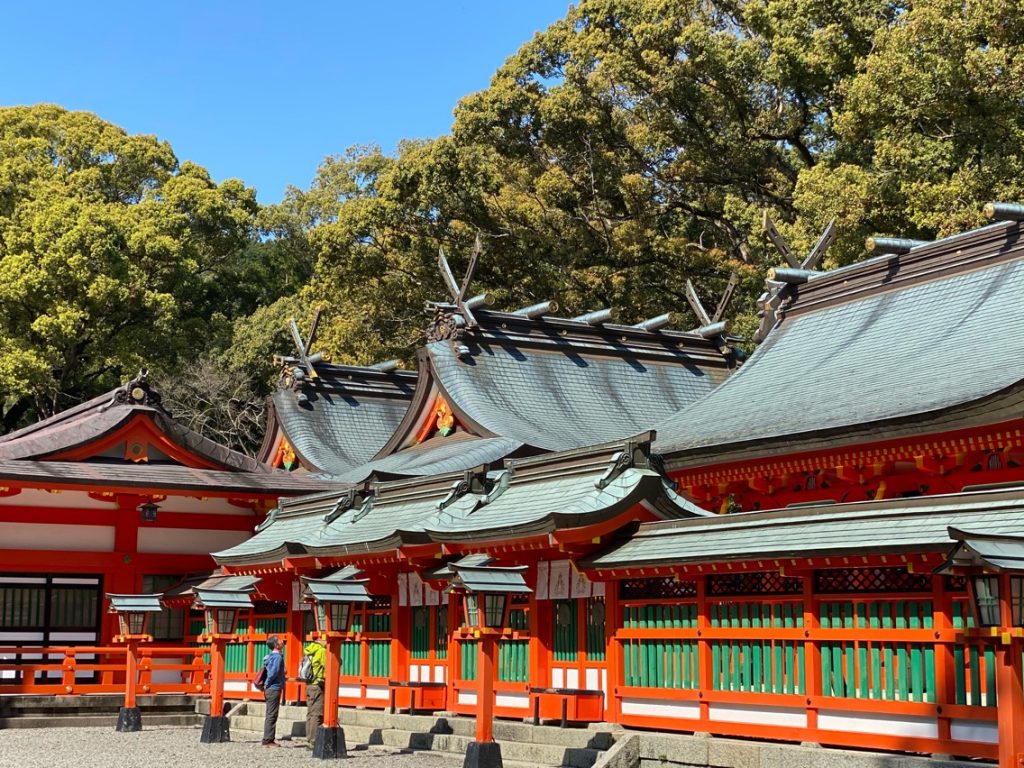
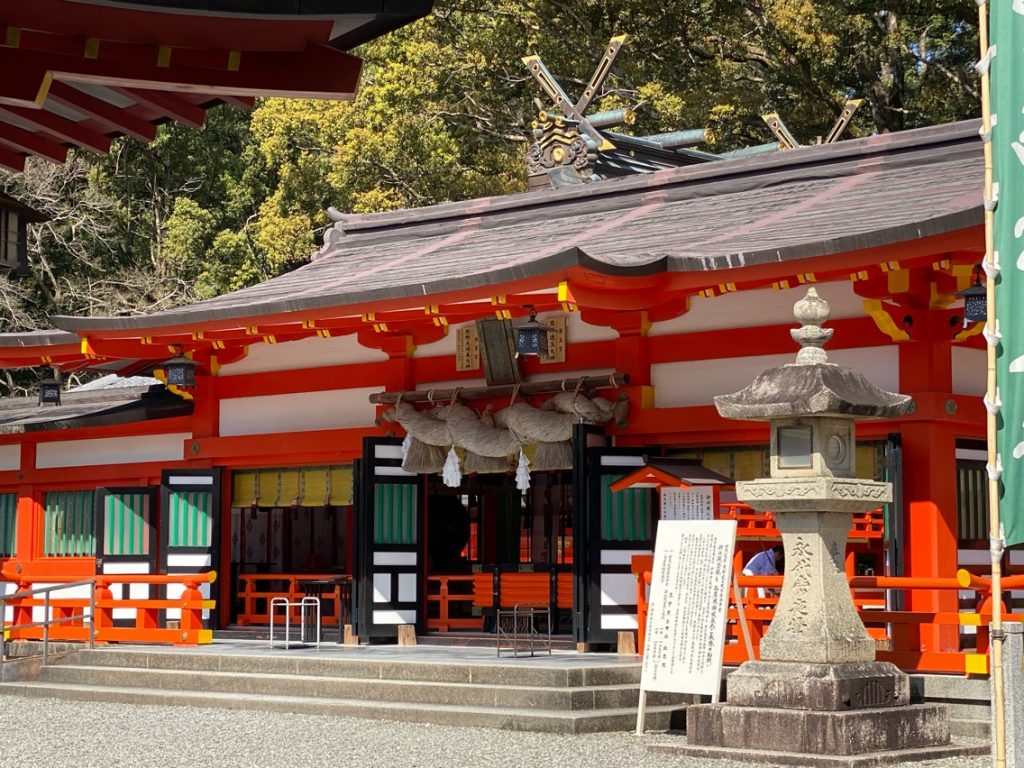
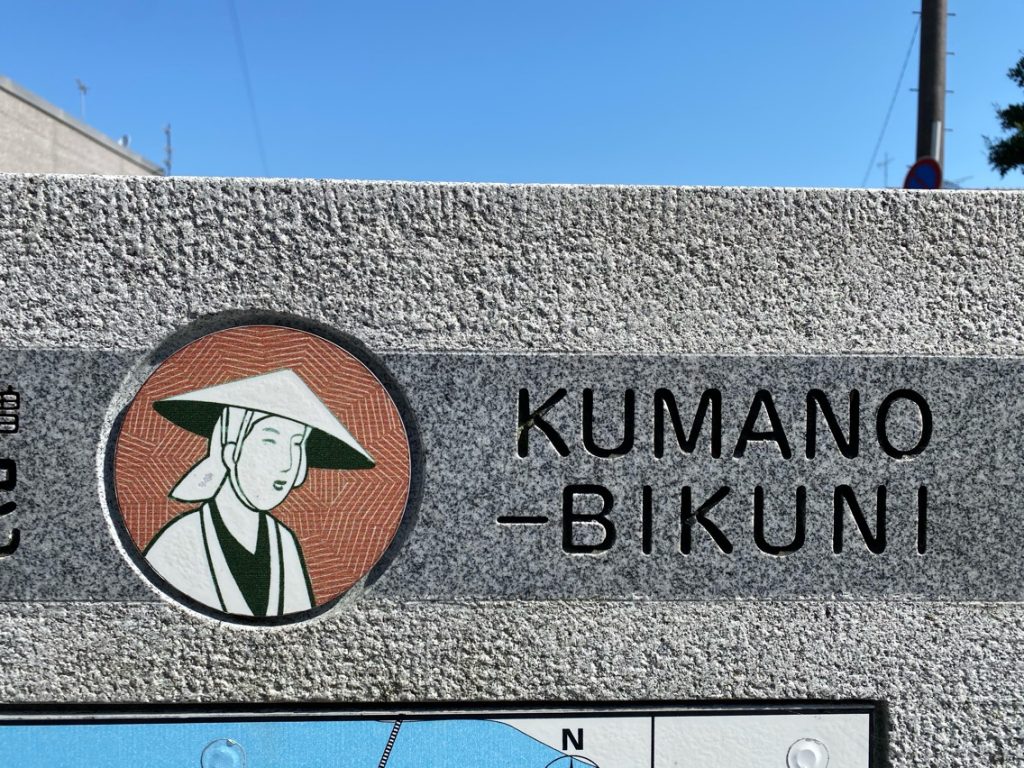


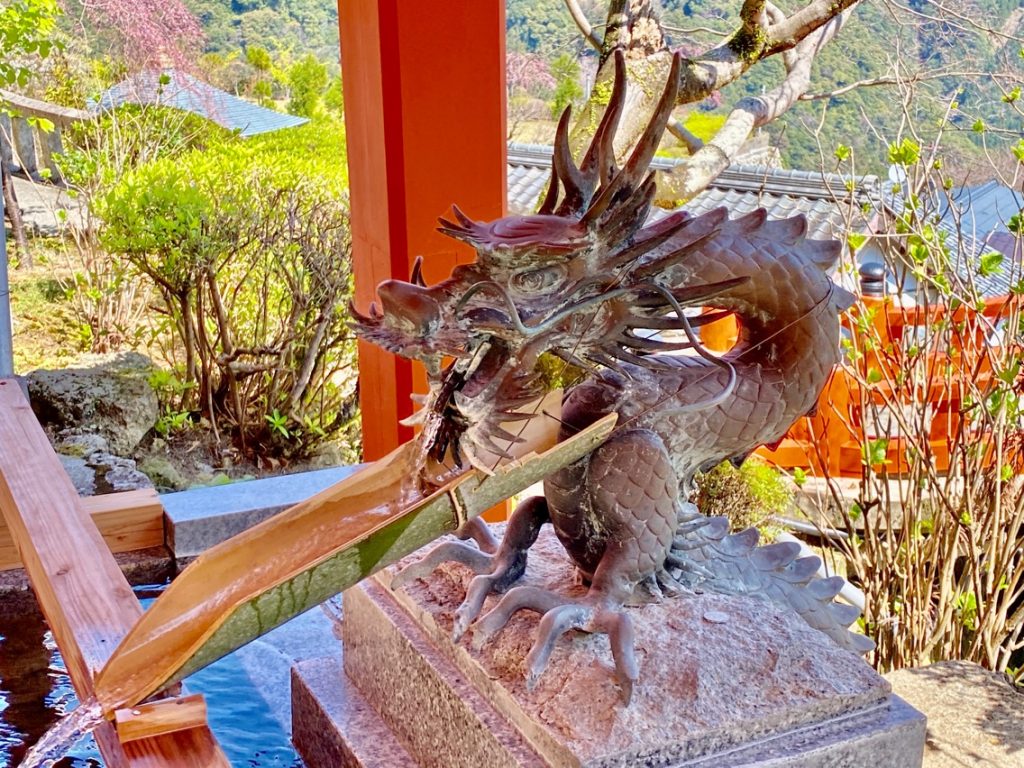








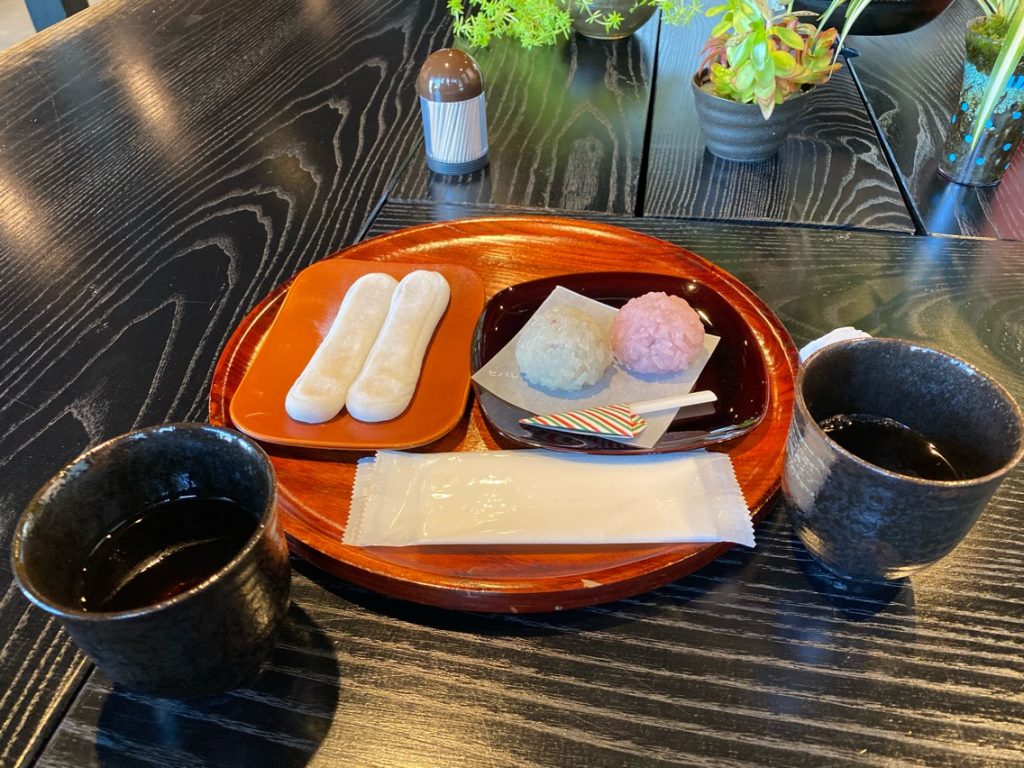








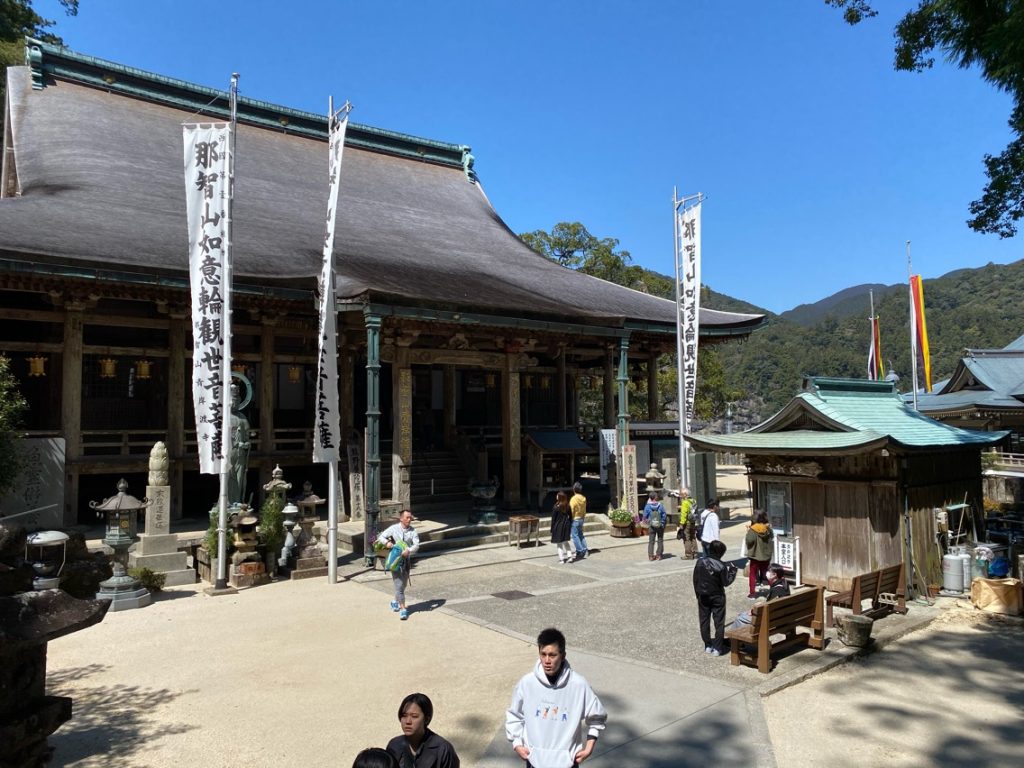
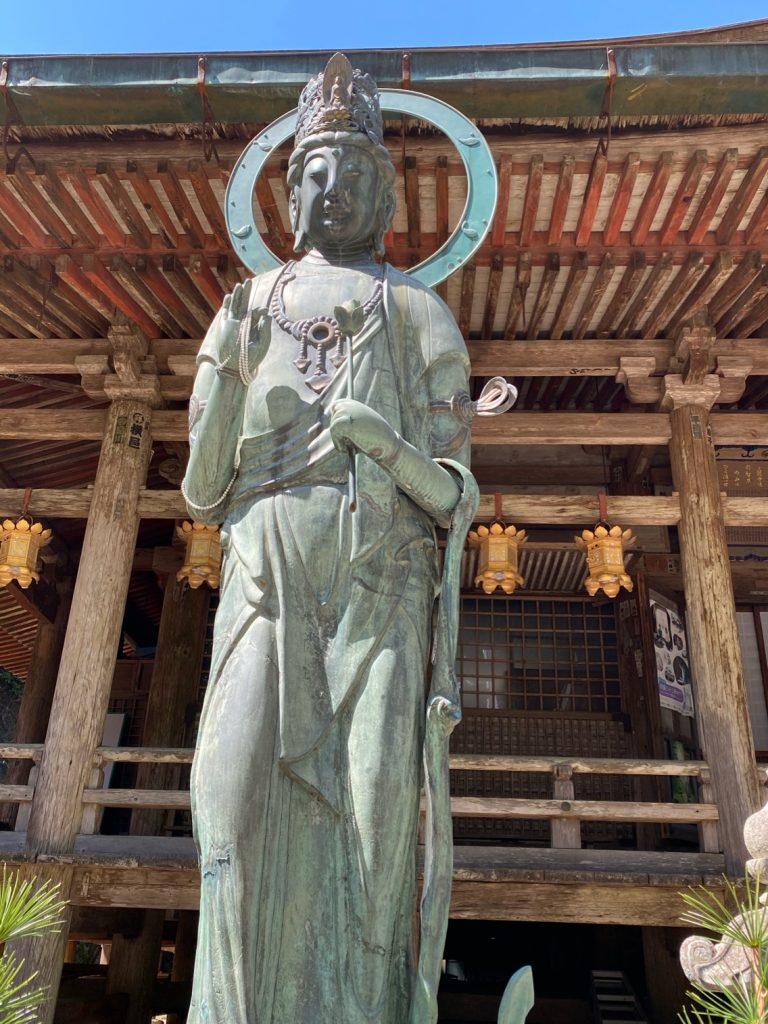
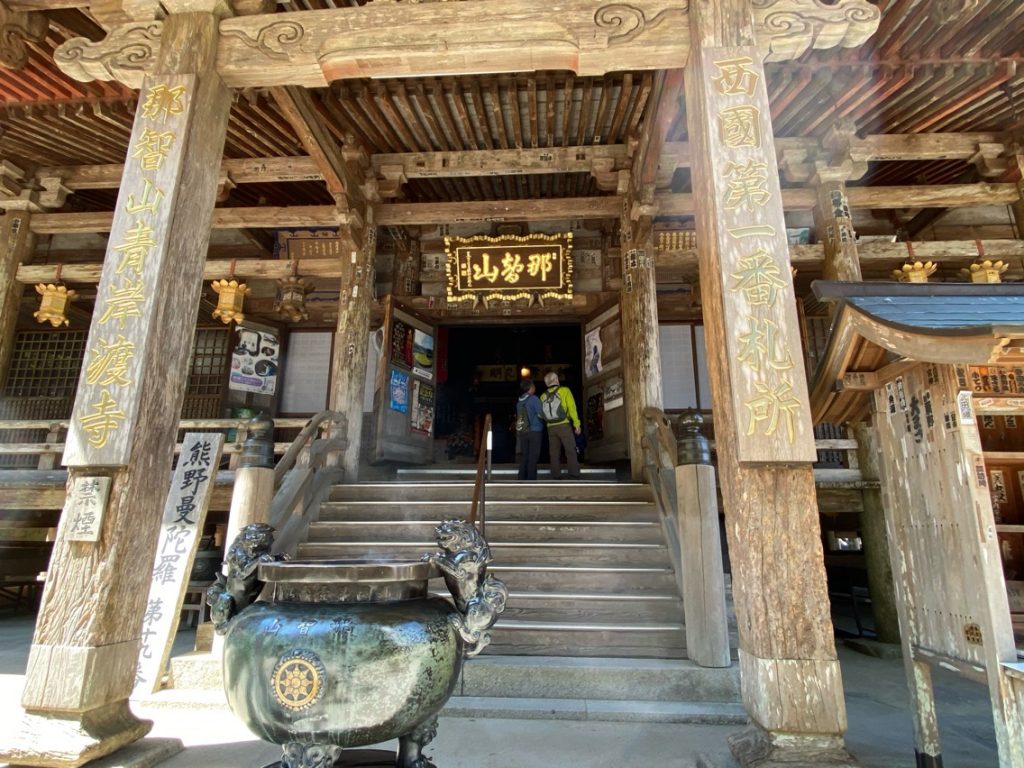

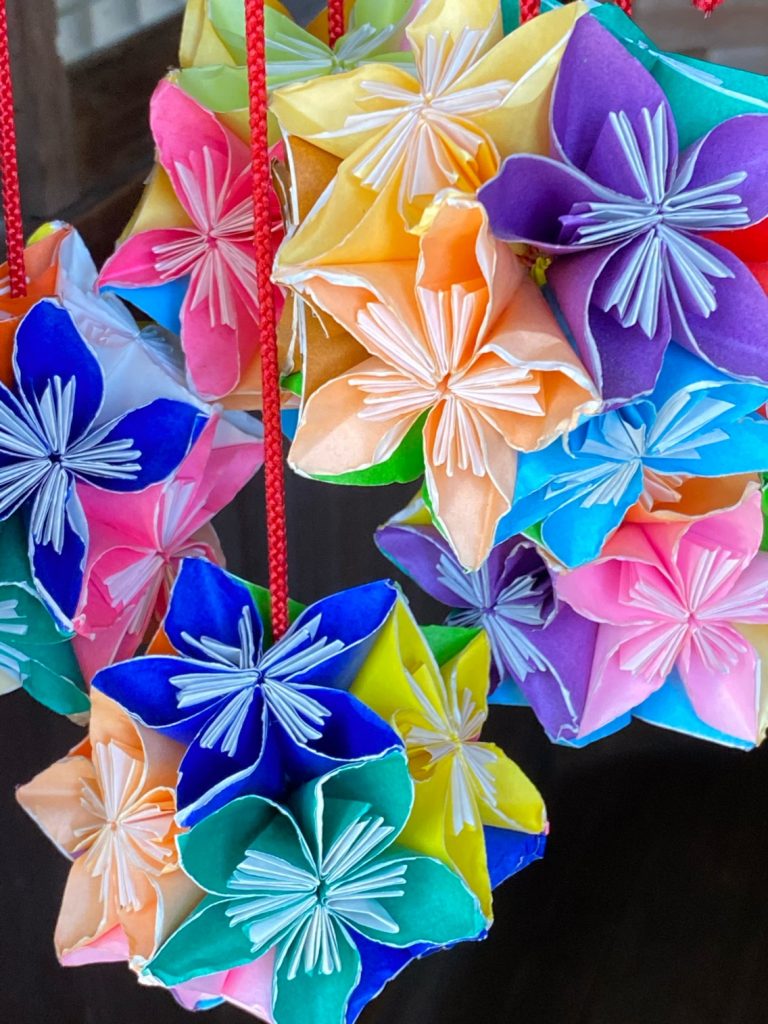






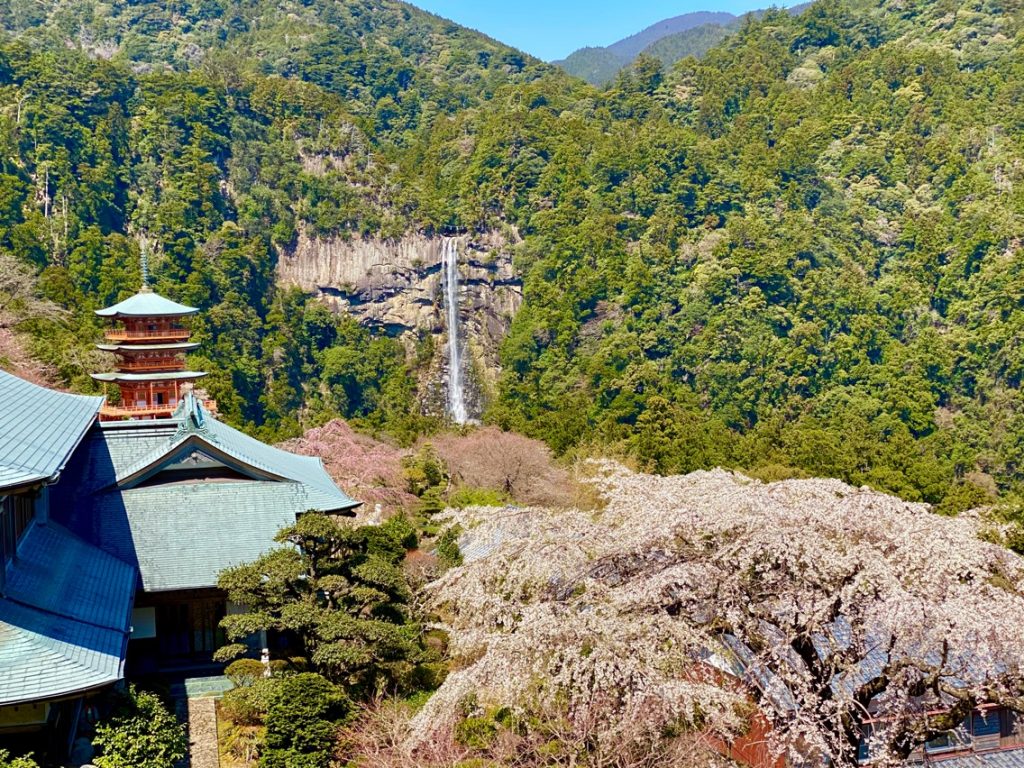















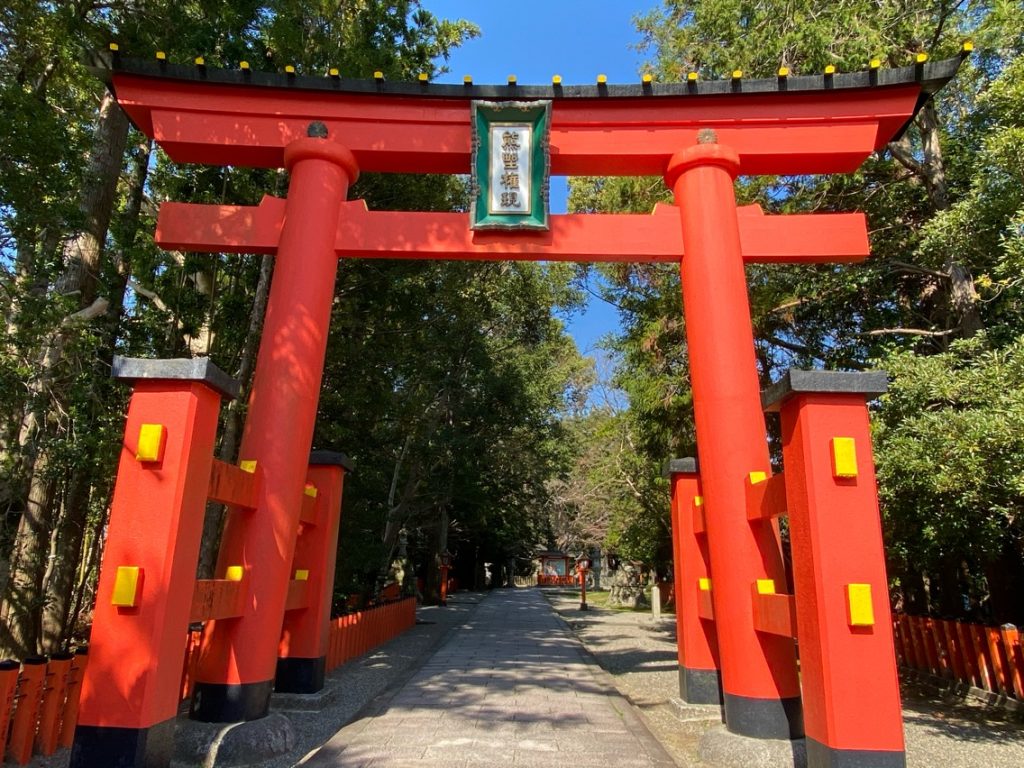

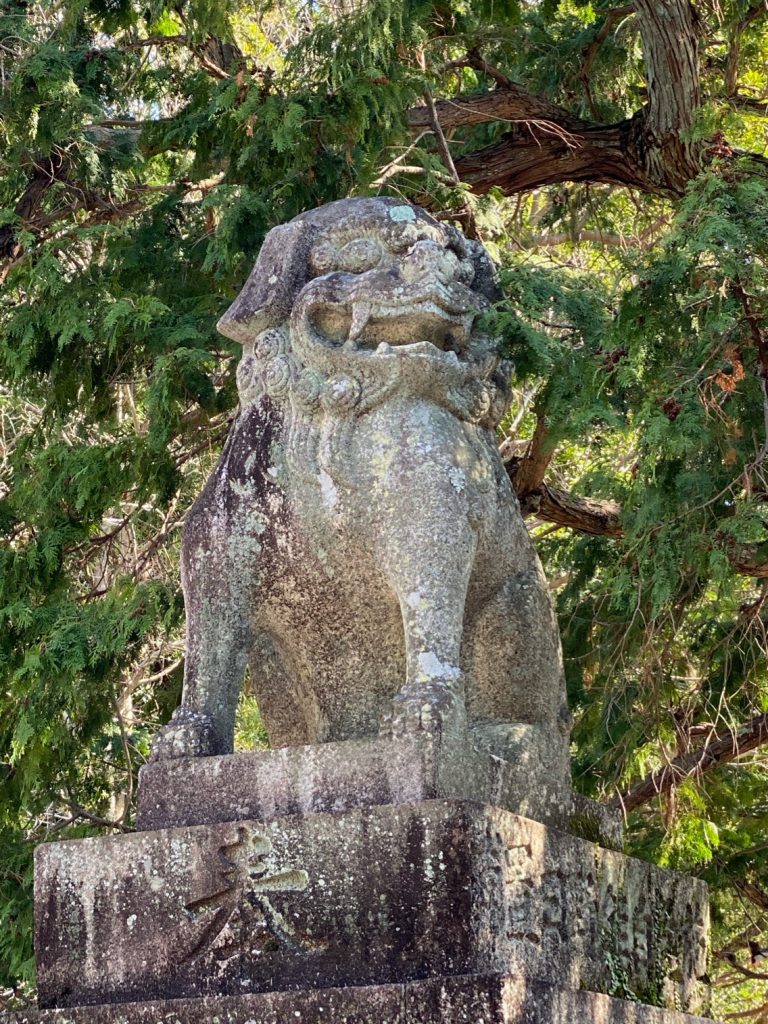
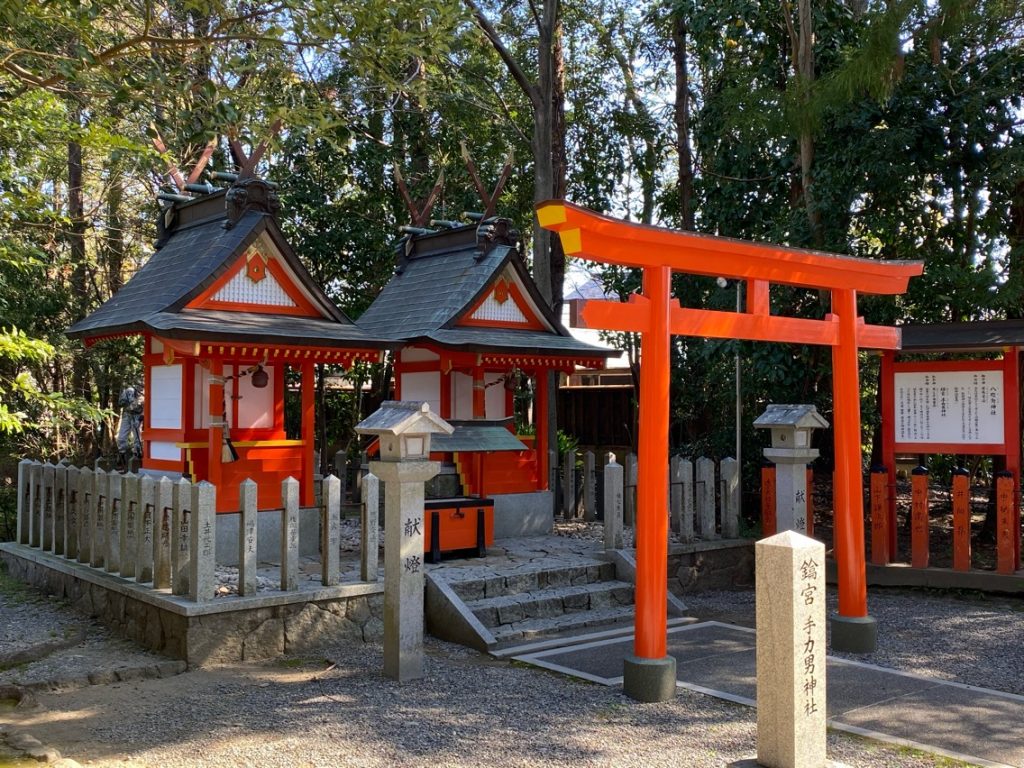


Day 7 - The Road To Enlightenment - Walking The Saigoku Kannon Pilgrimage - Hayatama-Taisha and Nachi-Taisha Grand Shrines, and Seiganto-ji, Temple #1, Wakayama, Japan
The guesthouse at which we stayed last night had a wall system that required us to deposit a ¥100 coin for every two hours of heating our room.
The night was cold, and we deposited enough coins to make sure to heat the room until morning.
The hallways on our nightly walks to the communal toilets were not heated, and were very cold.
But it was the only place to stay in Koguchi, which is midway to the Nachi-Taisha Grand Shrine.
We had met two other Japanese pilgrims last night at dinner, and saw in the hallway two others, plus the gay men couple we met on the trail, and the university student from the UK we met last night.
In the high season and not during coronavirus times, the place is filled beyond capacity, with people camping outside on the lawns.
We saw photos of hikers lined up like little ants, climbing the path to Nachi-San.
We decided to take the bus to Nachi-San, instead of walking the 14 kilometers of very hard, steep climbing up rocky and uneven stone steps.
My legs were tired after two weeks of walking, and I need to stay in good shape, in order to continue walking our Saigoku Kannon pilgrimage.
Besides, the stress of reading the sad global news is getting to both of us, and our nightly sleeps have not been so restful.
The bus took us to Shingu town, where we visited the Hayatama-Taisha, the third important Kumano Shrine.
We had planned to visit it tomorrow by bus anyway, because it is not on the Saigoku pilgrimage path.
When we got ready to get off the bus, the bus driver leafed through his bag and gave us a city map and the bus schedule for us to continue to Nachisan.
While he did all this, the other passengers waited patiently.
Nobody was rushing him, and he took his time to explained to me where to pick up the bus and how to walk to get to the shrine.
When we got off, I bowed and apologized to the passengers who were waiting so patiently.
They were very graceful, as if it were the most natural thing in the world, to be kind and helpful towards visitors.
Oh, how I wish the rest of the world will be as kind...
The Hayatama-Taisha is located at the spot where the Kumano River merges with the Pacific Ocean, in the town of Shingū.
It is a beautiful shrine, boldly painted in vermillion colors.
The Kumano Hayatama-Taisha has existed since ancient times.
The description of the shrine describes the origin of the Kumano Shinto religion:
“When exactly did our ancestors sense the existence of God?
The ancient people, who were living in the wilderness, had no guarantee of the continuity of life.
They lived unimaginably harsh lives.
Nature gives us unbelievable wonder, beauty and excitement, but also sufferings, hope and grace.
Nature can be violent and destroy human life and itself, but on the other hand, it is a spring of life that brings the blessings of warm light and fertility.
Human beings have always feared noble and holy things.
In Japanese ancestry, our ancestors did not worship a god of absolute perfection that transcended nature.
Instead, they wanted a fair and warm god, that exists in the great nature, the sun, the moon, the stars, the trees, the wind, the fire and the earth.
There are many sacred places that were created by nature in the Kumano, and the Shinto gods of the Kumano Sanzan descended on these special places.
Shinto and Buddhism merged here as soon as Buddhism was introduced in the sixth century, and the "Kumano Gongen religion" spread throughout the country.
“Gongen" means that God turns into a Buddha (provisional) in authority (provisional) and appears to save sentient beings.
It is believed that all beings, regardless of being strong or weak, regardless of their status, or if their nature is good or evil, or if they believe or disbelieve, they are all revered as gods, who have the Buddha nature, who are awaiting their salvation and enlightenment.
There are no separations between the God and us.
The Kumano Kodo path is usually taken by those who continue their hardships, in search of enlightenment and salvation.
It is said that everyone who finally arrives at the shrines of the Kumano had known hardships by crossing the steep mountain roads, and had cried tears of pain.
Our ancestors who served the gods of Kumano had warmly welcomed pilgrims to the worship hall, even if the pilgrims were wet with rain.
This hospitality is called the "Itsudo of Wet Straw Kutsu" and has become a moral code of Kumano Hayatama-Taisha.
The pilgrimage will refresh your mind, with beautiful emotional tears that will restore your original form.
The Kumano will restore your power to live again.
The journey is life-threatening.
It is a difficult trial, but you will regain the innocent heart that you had when you were born.
What lay at the end of the pilgrimage’s penance, is the blessing of courage and determination to start a new life without hesitation.
The real intention is that Kumano Hayatama-Taisha is said to be "the land of rebirth," which is exactly here where you stand.”
The Hayatama-Taisha has an ancient tree that is said to be over 800 years old, and is considered a sacred site.
There is also a museum here with dozens of national treasures and offerings brought by pilgrims from all around the world.
From there, we visited Nachi-San Mountain.
Our guesthouse is located halfway up the mountain.
Above it, up a steep set of stone stairs, was a beautiful complex of temples and shrines, with blooming cherry trees surrounded by a primeval forest of ancient trees.
First we walked around and visited the beautiful Nachi Shrine, painted in Vermillion colors, along with a three story pagoda, overlooking the beautiful Nachi Falls.
The Nachi Water Falls are 133 meters high, 13 meters wide, with a water flow of one ton per second.
This is actually the highest waterfall in Japan, and it is an object of worship in the Kumano-Nachi Grand Shrine.
A Fire Festival that takes place here on the 14th of July every year is considered to be one of the three biggest fire festivals in Japan.
There are also biannual festivals, around July and December each year, in which the rope tied above the waterfalls is replaced.
The main deity in the shrine is Izanami no Mikoto (The Kumano Fusumi God), who is a deity of unity.
Adjacent to the Shrine is our first temple on the Saigoku Kannon pilgrimage, the Seiganto-ji Temple.
The Seiganto-ji Temple was burnt and reconstructed a few times.
The present main building was re-built in the year 1590, by Hideyoshi Toyotomi, one of the most famous samurai generals in Japan.
The temple is the first temple of the pilgrimage to 33 temples housing Kannons of Compassion.
The pilgrimage was made famous by the retired emperor Kazan, who in the 10th century, walked the entire route and composed poems at each temple.
The Saigoku Kannon pilgrimage became popular among commoners during the Edo period (1603-1868).
It is said that this temple was founded by an Indian monk, called Ragyo Shonin, in the 4th century.
Some ascetic monks lived here in isolation, and practiced mountain asceticism for a thousand days, in order to gain spiritual and supernatural power.
Part of the practices they did included sitting in the freezing cold waters of waterfalls, while making incantations.
The Goddess of compassion, Kannon, appeared before Shonin, and when she disappeared at the base of the falls, Shonin found a 25cm-tall Kannon image.
He enshrined it in a thatched hut next to the waterfalls, and later it was moved a bit farther to what is now the location of the temple.
Later when a larger Kannon was established as the main deity of the temple, they enclosed the small Kannon statue that Shonin had found, inside it.
After we finished our prayers and chanting at the Temple, we sat at an outdoor table next to the Pagoda, which directly overlooks the waterfalls.
We had our packed lunch in the warm, bright sun.
A couple of hikers from Holland sat next to us and had their own packed lunch.
Then we walked into the village, settling into a café across the street from our guesthouse.
After we ordered Mehari Sushi Rice balls, they were kind enough to give us a big pot of hot tea, which we sat and drank.
I was smiling encouragingly at the old grandmother, who was sitting by a heater, coughing and cleaning her nose repeatedly.
It is so sad to grow old like that....
Even if you are surrounded by loved ones and are not living on welfare, life without awareness of your inherited spiritual powers is a sad life....
Reading in the news about the coronavirus lockdowns and shutdowns around the world, I decided to buy a pilgrim’s jacket to wear as we walk.
When we walked the famous Kumano Kodo, everyone knew we were pilgrims.
But nobody walks the Saigoku.
It encompasses a great distance and it is not walked anymore, unlike the Shikoku 88 temple pilgrimage, which is well known all over Japan.
I thought that it is best that when people see us walking, they would know that we are not just tourists but spiritual pilgrims, who bring light and blessings wherever they go, in an attempt to light up the world and spread spiritual illumination and blessings from eternity.
The old grandmother and her elderly daughter helped me try on the white pilgrimage jacket.
We were given a nice large tatami mat room at the guesthouse and were allowed to take a hot bath together, since there were no other guests.
Dinner was a lovely vegetarian Kaiseki meal, but we ate too much food and we drank a glass of plum wine, which made me a bit drunk.
I drifted off to sleep the minute my head rested on the rice pillow.
With blessings of light,
Tali
Daily stats:
Steps walked - 9,171
7 km. walked
Active walking time - 2 hours
Total walking time today - 5 hours.
Total walking distance on the Saigoku to date - 123 km
Temples Visited:
Hayatama-Taisha Grand Shrine
Nachi-Taisha Grand Shrine
Temple #1, Seiganto-ji
































































 Day 7 - The Road To Enlightenment - Walking The Saigoku Kannon Pilgrimage - Hayatama-Taisha and Nachi-Taisha Grand Shrines, and Seiganto-ji, Temple #1, Wakayama, Japan
The guesthouse at which we stayed last night had a wall system that required us to deposit a ¥100 coin for every two hours of heating our room.
The night was cold, and we deposited enough coins to make sure to heat the room until morning.
The hallways on our nightly walks to the communal toilets were not heated, and were very cold.
But it was the only place to stay in Koguchi, which is midway to the Nachi-Taisha Grand Shrine.
We had met two other Japanese pilgrims last night at dinner, and saw in the hallway two others, plus the gay men couple we met on the trail, and the university student from the UK we met last night.
In the high season and not during coronavirus times, the place is filled beyond capacity, with people camping outside on the lawns.
We saw photos of hikers lined up like little ants, climbing the path to Nachi-San.
We decided to take the bus to Nachi-San, instead of walking the 14 kilometers of very hard, steep climbing up rocky and uneven stone steps.
My legs were tired after two weeks of walking, and I need to stay in good shape, in order to continue walking our Saigoku Kannon pilgrimage.
Besides, the stress of reading the sad global news is getting to both of us, and our nightly sleeps have not been so restful.
The bus took us to Shingu town, where we visited the Hayatama-Taisha, the third important Kumano Shrine.
We had planned to visit it tomorrow by bus anyway, because it is not on the Saigoku pilgrimage path.
When we got ready to get off the bus, the bus driver leafed through his bag and gave us a city map and the bus schedule for us to continue to Nachisan.
While he did all this, the other passengers waited patiently.
Nobody was rushing him, and he took his time to explained to me where to pick up the bus and how to walk to get to the shrine.
When we got off, I bowed and apologized to the passengers who were waiting so patiently.
They were very graceful, as if it were the most natural thing in the world, to be kind and helpful towards visitors.
Oh, how I wish the rest of the world will be as kind...
The Hayatama-Taisha is located at the spot where the Kumano River merges with the Pacific Ocean, in the town of Shingū.
It is a beautiful shrine, boldly painted in vermillion colors.
The Kumano Hayatama-Taisha has existed since ancient times.
The description of the shrine describes the origin of the Kumano Shinto religion:
“When exactly did our ancestors sense the existence of God?
The ancient people, who were living in the wilderness, had no guarantee of the continuity of life.
They lived unimaginably harsh lives.
Nature gives us unbelievable wonder, beauty and excitement, but also sufferings, hope and grace.
Nature can be violent and destroy human life and itself, but on the other hand, it is a spring of life that brings the blessings of warm light and fertility.
Human beings have always feared noble and holy things.
In Japanese ancestry, our ancestors did not worship a god of absolute perfection that transcended nature.
Instead, they wanted a fair and warm god, that exists in the great nature, the sun, the moon, the stars, the trees, the wind, the fire and the earth.
There are many sacred places that were created by nature in the Kumano, and the Shinto gods of the Kumano Sanzan descended on these special places.
Shinto and Buddhism merged here as soon as Buddhism was introduced in the sixth century, and the "Kumano Gongen religion" spread throughout the country.
“Gongen" means that God turns into a Buddha (provisional) in authority (provisional) and appears to save sentient beings.
It is believed that all beings, regardless of being strong or weak, regardless of their status, or if their nature is good or evil, or if they believe or disbelieve, they are all revered as gods, who have the Buddha nature, who are awaiting their salvation and enlightenment.
There are no separations between the God and us.
The Kumano Kodo path is usually taken by those who continue their hardships, in search of enlightenment and salvation.
It is said that everyone who finally arrives at the shrines of the Kumano had known hardships by crossing the steep mountain roads, and had cried tears of pain.
Our ancestors who served the gods of Kumano had warmly welcomed pilgrims to the worship hall, even if the pilgrims were wet with rain.
This hospitality is called the "Itsudo of Wet Straw Kutsu" and has become a moral code of Kumano Hayatama-Taisha.
The pilgrimage will refresh your mind, with beautiful emotional tears that will restore your original form.
The Kumano will restore your power to live again.
The journey is life-threatening.
It is a difficult trial, but you will regain the innocent heart that you had when you were born.
What lay at the end of the pilgrimage’s penance, is the blessing of courage and determination to start a new life without hesitation.
The real intention is that Kumano Hayatama-Taisha is said to be "the land of rebirth," which is exactly here where you stand.”
The Hayatama-Taisha has an ancient tree that is said to be over 800 years old, and is considered a sacred site.
There is also a museum here with dozens of national treasures and offerings brought by pilgrims from all around the world.
From there, we visited Nachi-San Mountain.
Our guesthouse is located halfway up the mountain.
Above it, up a steep set of stone stairs, was a beautiful complex of temples and shrines, with blooming cherry trees surrounded by a primeval forest of ancient trees.
First we walked around and visited the beautiful Nachi Shrine, painted in Vermillion colors, along with a three story pagoda, overlooking the beautiful Nachi Falls.
The Nachi Water Falls are 133 meters high, 13 meters wide, with a water flow of one ton per second.
This is actually the highest waterfall in Japan, and it is an object of worship in the Kumano-Nachi Grand Shrine.
A Fire Festival that takes place here on the 14th of July every year is considered to be one of the three biggest fire festivals in Japan.
There are also biannual festivals, around July and December each year, in which the rope tied above the waterfalls is replaced.
The main deity in the shrine is Izanami no Mikoto (The Kumano Fusumi God), who is a deity of unity.
Adjacent to the Shrine is our first temple on the Saigoku Kannon pilgrimage, the Seiganto-ji Temple.
The Seiganto-ji Temple was burnt and reconstructed a few times.
The present main building was re-built in the year 1590, by Hideyoshi Toyotomi, one of the most famous samurai generals in Japan.
The temple is the first temple of the pilgrimage to 33 temples housing Kannons of Compassion.
The pilgrimage was made famous by the retired emperor Kazan, who in the 10th century, walked the entire route and composed poems at each temple.
The Saigoku Kannon pilgrimage became popular among commoners during the Edo period (1603-1868).
It is said that this temple was founded by an Indian monk, called Ragyo Shonin, in the 4th century.
Some ascetic monks lived here in isolation, and practiced mountain asceticism for a thousand days, in order to gain spiritual and supernatural power.
Part of the practices they did included sitting in the freezing cold waters of waterfalls, while making incantations.
The Goddess of compassion, Kannon, appeared before Shonin, and when she disappeared at the base of the falls, Shonin found a 25cm-tall Kannon image.
He enshrined it in a thatched hut next to the waterfalls, and later it was moved a bit farther to what is now the location of the temple.
Later when a larger Kannon was established as the main deity of the temple, they enclosed the small Kannon statue that Shonin had found, inside it.
After we finished our prayers and chanting at the Temple, we sat at an outdoor table next to the Pagoda, which directly overlooks the waterfalls.
We had our packed lunch in the warm, bright sun.
A couple of hikers from Holland sat next to us and had their own packed lunch.
Then we walked into the village, settling into a café across the street from our guesthouse.
After we ordered Mehari Sushi Rice balls, they were kind enough to give us a big pot of hot tea, which we sat and drank.
I was smiling encouragingly at the old grandmother, who was sitting by a heater, coughing and cleaning her nose repeatedly.
It is so sad to grow old like that....
Even if you are surrounded by loved ones and are not living on welfare, life without awareness of your inherited spiritual powers is a sad life....
Reading in the news about the coronavirus lockdowns and shutdowns around the world, I decided to buy a pilgrim’s jacket to wear as we walk.
When we walked the famous Kumano Kodo, everyone knew we were pilgrims.
But nobody walks the Saigoku.
It encompasses a great distance and it is not walked anymore, unlike the Shikoku 88 temple pilgrimage, which is well known all over Japan.
I thought that it is best that when people see us walking, they would know that we are not just tourists but spiritual pilgrims, who bring light and blessings wherever they go, in an attempt to light up the world and spread spiritual illumination and blessings from eternity.
The old grandmother and her elderly daughter helped me try on the white pilgrimage jacket.
We were given a nice large tatami mat room at the guesthouse and were allowed to take a hot bath together, since there were no other guests.
Dinner was a lovely vegetarian Kaiseki meal, but we ate too much food and we drank a glass of plum wine, which made me a bit drunk.
I drifted off to sleep the minute my head rested on the rice pillow.
With blessings of light,
Tali
Daily stats:
Steps walked - 9,171
7 km. walked
Active walking time - 2 hours
Total walking time today - 5 hours.
Total walking distance on the Saigoku to date - 123 km
Temples Visited:
Hayatama-Taisha Grand Shrine
Nachi-Taisha Grand Shrine
Temple #1, Seiganto-ji
Day 7 - The Road To Enlightenment - Walking The Saigoku Kannon Pilgrimage - Hayatama-Taisha and Nachi-Taisha Grand Shrines, and Seiganto-ji, Temple #1, Wakayama, Japan
The guesthouse at which we stayed last night had a wall system that required us to deposit a ¥100 coin for every two hours of heating our room.
The night was cold, and we deposited enough coins to make sure to heat the room until morning.
The hallways on our nightly walks to the communal toilets were not heated, and were very cold.
But it was the only place to stay in Koguchi, which is midway to the Nachi-Taisha Grand Shrine.
We had met two other Japanese pilgrims last night at dinner, and saw in the hallway two others, plus the gay men couple we met on the trail, and the university student from the UK we met last night.
In the high season and not during coronavirus times, the place is filled beyond capacity, with people camping outside on the lawns.
We saw photos of hikers lined up like little ants, climbing the path to Nachi-San.
We decided to take the bus to Nachi-San, instead of walking the 14 kilometers of very hard, steep climbing up rocky and uneven stone steps.
My legs were tired after two weeks of walking, and I need to stay in good shape, in order to continue walking our Saigoku Kannon pilgrimage.
Besides, the stress of reading the sad global news is getting to both of us, and our nightly sleeps have not been so restful.
The bus took us to Shingu town, where we visited the Hayatama-Taisha, the third important Kumano Shrine.
We had planned to visit it tomorrow by bus anyway, because it is not on the Saigoku pilgrimage path.
When we got ready to get off the bus, the bus driver leafed through his bag and gave us a city map and the bus schedule for us to continue to Nachisan.
While he did all this, the other passengers waited patiently.
Nobody was rushing him, and he took his time to explained to me where to pick up the bus and how to walk to get to the shrine.
When we got off, I bowed and apologized to the passengers who were waiting so patiently.
They were very graceful, as if it were the most natural thing in the world, to be kind and helpful towards visitors.
Oh, how I wish the rest of the world will be as kind...
The Hayatama-Taisha is located at the spot where the Kumano River merges with the Pacific Ocean, in the town of Shingū.
It is a beautiful shrine, boldly painted in vermillion colors.
The Kumano Hayatama-Taisha has existed since ancient times.
The description of the shrine describes the origin of the Kumano Shinto religion:
“When exactly did our ancestors sense the existence of God?
The ancient people, who were living in the wilderness, had no guarantee of the continuity of life.
They lived unimaginably harsh lives.
Nature gives us unbelievable wonder, beauty and excitement, but also sufferings, hope and grace.
Nature can be violent and destroy human life and itself, but on the other hand, it is a spring of life that brings the blessings of warm light and fertility.
Human beings have always feared noble and holy things.
In Japanese ancestry, our ancestors did not worship a god of absolute perfection that transcended nature.
Instead, they wanted a fair and warm god, that exists in the great nature, the sun, the moon, the stars, the trees, the wind, the fire and the earth.
There are many sacred places that were created by nature in the Kumano, and the Shinto gods of the Kumano Sanzan descended on these special places.
Shinto and Buddhism merged here as soon as Buddhism was introduced in the sixth century, and the "Kumano Gongen religion" spread throughout the country.
“Gongen" means that God turns into a Buddha (provisional) in authority (provisional) and appears to save sentient beings.
It is believed that all beings, regardless of being strong or weak, regardless of their status, or if their nature is good or evil, or if they believe or disbelieve, they are all revered as gods, who have the Buddha nature, who are awaiting their salvation and enlightenment.
There are no separations between the God and us.
The Kumano Kodo path is usually taken by those who continue their hardships, in search of enlightenment and salvation.
It is said that everyone who finally arrives at the shrines of the Kumano had known hardships by crossing the steep mountain roads, and had cried tears of pain.
Our ancestors who served the gods of Kumano had warmly welcomed pilgrims to the worship hall, even if the pilgrims were wet with rain.
This hospitality is called the "Itsudo of Wet Straw Kutsu" and has become a moral code of Kumano Hayatama-Taisha.
The pilgrimage will refresh your mind, with beautiful emotional tears that will restore your original form.
The Kumano will restore your power to live again.
The journey is life-threatening.
It is a difficult trial, but you will regain the innocent heart that you had when you were born.
What lay at the end of the pilgrimage’s penance, is the blessing of courage and determination to start a new life without hesitation.
The real intention is that Kumano Hayatama-Taisha is said to be "the land of rebirth," which is exactly here where you stand.”
The Hayatama-Taisha has an ancient tree that is said to be over 800 years old, and is considered a sacred site.
There is also a museum here with dozens of national treasures and offerings brought by pilgrims from all around the world.
From there, we visited Nachi-San Mountain.
Our guesthouse is located halfway up the mountain.
Above it, up a steep set of stone stairs, was a beautiful complex of temples and shrines, with blooming cherry trees surrounded by a primeval forest of ancient trees.
First we walked around and visited the beautiful Nachi Shrine, painted in Vermillion colors, along with a three story pagoda, overlooking the beautiful Nachi Falls.
The Nachi Water Falls are 133 meters high, 13 meters wide, with a water flow of one ton per second.
This is actually the highest waterfall in Japan, and it is an object of worship in the Kumano-Nachi Grand Shrine.
A Fire Festival that takes place here on the 14th of July every year is considered to be one of the three biggest fire festivals in Japan.
There are also biannual festivals, around July and December each year, in which the rope tied above the waterfalls is replaced.
The main deity in the shrine is Izanami no Mikoto (The Kumano Fusumi God), who is a deity of unity.
Adjacent to the Shrine is our first temple on the Saigoku Kannon pilgrimage, the Seiganto-ji Temple.
The Seiganto-ji Temple was burnt and reconstructed a few times.
The present main building was re-built in the year 1590, by Hideyoshi Toyotomi, one of the most famous samurai generals in Japan.
The temple is the first temple of the pilgrimage to 33 temples housing Kannons of Compassion.
The pilgrimage was made famous by the retired emperor Kazan, who in the 10th century, walked the entire route and composed poems at each temple.
The Saigoku Kannon pilgrimage became popular among commoners during the Edo period (1603-1868).
It is said that this temple was founded by an Indian monk, called Ragyo Shonin, in the 4th century.
Some ascetic monks lived here in isolation, and practiced mountain asceticism for a thousand days, in order to gain spiritual and supernatural power.
Part of the practices they did included sitting in the freezing cold waters of waterfalls, while making incantations.
The Goddess of compassion, Kannon, appeared before Shonin, and when she disappeared at the base of the falls, Shonin found a 25cm-tall Kannon image.
He enshrined it in a thatched hut next to the waterfalls, and later it was moved a bit farther to what is now the location of the temple.
Later when a larger Kannon was established as the main deity of the temple, they enclosed the small Kannon statue that Shonin had found, inside it.
After we finished our prayers and chanting at the Temple, we sat at an outdoor table next to the Pagoda, which directly overlooks the waterfalls.
We had our packed lunch in the warm, bright sun.
A couple of hikers from Holland sat next to us and had their own packed lunch.
Then we walked into the village, settling into a café across the street from our guesthouse.
After we ordered Mehari Sushi Rice balls, they were kind enough to give us a big pot of hot tea, which we sat and drank.
I was smiling encouragingly at the old grandmother, who was sitting by a heater, coughing and cleaning her nose repeatedly.
It is so sad to grow old like that....
Even if you are surrounded by loved ones and are not living on welfare, life without awareness of your inherited spiritual powers is a sad life....
Reading in the news about the coronavirus lockdowns and shutdowns around the world, I decided to buy a pilgrim’s jacket to wear as we walk.
When we walked the famous Kumano Kodo, everyone knew we were pilgrims.
But nobody walks the Saigoku.
It encompasses a great distance and it is not walked anymore, unlike the Shikoku 88 temple pilgrimage, which is well known all over Japan.
I thought that it is best that when people see us walking, they would know that we are not just tourists but spiritual pilgrims, who bring light and blessings wherever they go, in an attempt to light up the world and spread spiritual illumination and blessings from eternity.
The old grandmother and her elderly daughter helped me try on the white pilgrimage jacket.
We were given a nice large tatami mat room at the guesthouse and were allowed to take a hot bath together, since there were no other guests.
Dinner was a lovely vegetarian Kaiseki meal, but we ate too much food and we drank a glass of plum wine, which made me a bit drunk.
I drifted off to sleep the minute my head rested on the rice pillow.
With blessings of light,
Tali
Daily stats:
Steps walked - 9,171
7 km. walked
Active walking time - 2 hours
Total walking time today - 5 hours.
Total walking distance on the Saigoku to date - 123 km
Temples Visited:
Hayatama-Taisha Grand Shrine
Nachi-Taisha Grand Shrine
Temple #1, Seiganto-ji